Your sense of smell and taste work through specialized receptors that detect chemical molecules—airborne ones for smell and soluble ones for taste. When these molecules bind to receptors, they trigger signals that travel to your brain, creating the sensations of aroma and flavor. The structure and exact shape of these molecules, especially their chirality, influence how you perceive different smells and tastes. Exploring this fascinating chemistry reveals how your senses transform chemicals into the vivid experiences you enjoy.
Key Takeaways
- Olfactory receptors detect airborne molecules by binding to specific chemical features, triggering signals sent to the brain.
- Taste receptors on the tongue respond to soluble tastants via G-protein-coupled or ion channels, producing neural signals.
- Sensory transduction converts chemical binding into electrical signals through depolarization of sensory cells.
- Flavor perception results from the integration of taste and retronasal olfactory signals in the brain.
- Molecular chirality influences how scents and tastes are perceived, with enantiomers having distinct sensory effects.
The Role of Olfactory Receptors in Detecting Airborne Molecules
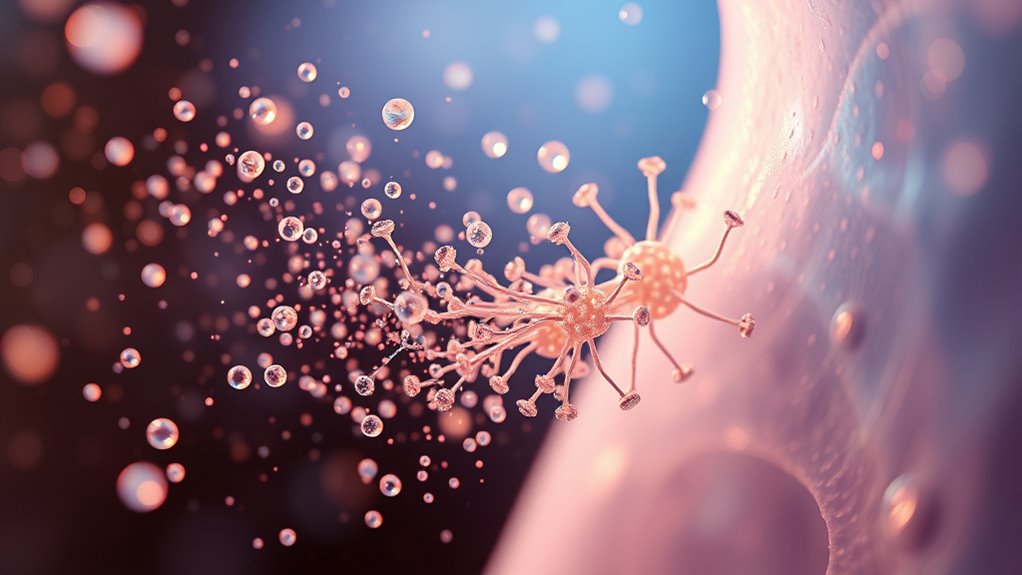
Olfactory receptors play a crucial role in detecting airborne molecules that carry smells. When you breathe in, odor molecules enter your nose and reach the olfactory epithelium. There, they bind to specific receptor sites on specialized olfactory receptor cells. Each receptor is designed to recognize certain molecular features based on size, shape, and chemical properties. This binding triggers a chemical signal that travels along the olfactory nerve to your brain. Humans have around 350 different types of olfactory receptors, allowing you to detect about 10,000 distinct odors through various combinations. The diversity of receptor structures ensures you can perceive a wide array of smells, from floral scents to rotten odors. The olfactory nerve is the shortest sensory nerve in the body, and this intricate detection system forms the foundation of your sense of smell. A diverse receptor repertoire enables humans to distinguish countless unique scents, making smell a complex and vital sense.
How Taste Receptors Sense Soluble Chemicals on Your Tongue

Taste receptors on your tongue detect soluble chemicals in food by interacting directly with molecules dissolved in saliva. Different types of receptors respond to specific tastes: G protein-coupled receptors (GPCRs) for sweet, umami, and bitter, and ion channels for sour and salty. Taste buds are grouped into taste papillae on the tongue surface, facilitating organized detection of various taste stimuli. Most taste stimuli, except for bitter substances, are water-soluble, allowing them to dissolve easily and reach the receptors. When a molecule binds to a receptor, it causes depolarization of the gustatory cell, leading to the release of neurotransmitters that send signals to your brain. For example, sodium ions trigger salty taste, hydrogen ions activate sour receptors, and sugars or amino acids stimulate sweet and umami receptors. This chemical interaction enables you to perceive and differentiate various tastes, shaping your flavor experience. Additionally, understanding the chemical mechanisms behind taste can inform innovations in flavor enhancement and food safety.
The Significance of Chirality in Flavor and Fragrance Molecules

The way molecules interact with your senses depends not only on their chemical composition but also on their three-dimensional arrangement. Chirality refers to how atoms are spatially arranged in a molecule, creating mirror images called enantiomers. Despite sharing the same formula, enantiomers often have different odors and tastes because they interact differently with biological receptors. Chirality significantly influences sensory experiences such as taste and smell by affecting how molecules interact with sensory receptors. For example, R-limonene smells like orange, while S-limonene resembles lemon, showing how chirality influences perception. In perfumery and flavoring, chiral molecules are essential for crafting specific scents and tastes. They interact uniquely with olfactory and gustatory receptors, leading to diverse sensory experiences. Understanding chirality allows chemists and perfumers to design targeted, complex fragrances and flavors that appeal to your senses.
Sensory Transduction: Turning Chemical Signals Into Neural Impulses
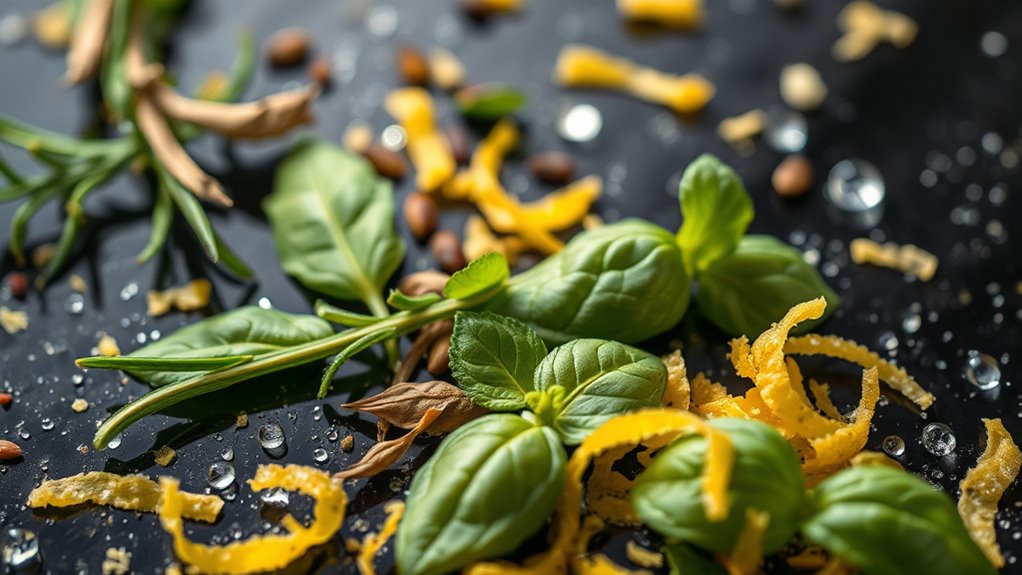
Sensory transduction is the process by which your body converts physical or chemical stimuli into electrical signals that your brain can interpret. When you encounter stimuli like light, sound, touch, taste, or smell, specialized receptors detect these signals. In taste and smell, chemical molecules bind to specific receptors—ionotropic, metabotropic, or G-protein coupled—triggering a cascade of events. This leads to ion movement across cell membranes, causing depolarization of the sensory cells. The depolarized cells generate action potentials transmitted by afferent neurons to your brain. These electrical signals are then processed, allowing you to perceive flavors or odors. Receptor specificity ensures that sensory signals are accurately transmitted, maintaining the integrity of your sensory perception. Additionally, the efficiency of this process depends on the proper functioning of the sensory transduction mechanisms, which are crucial for accurate environmental interpretation. Sensory transduction guarantees your brain receives clear, distinct information from your environment, enabling you to interpret and respond to the world around you accurately.
The Interaction Between Taste and Smell in Flavor Perception
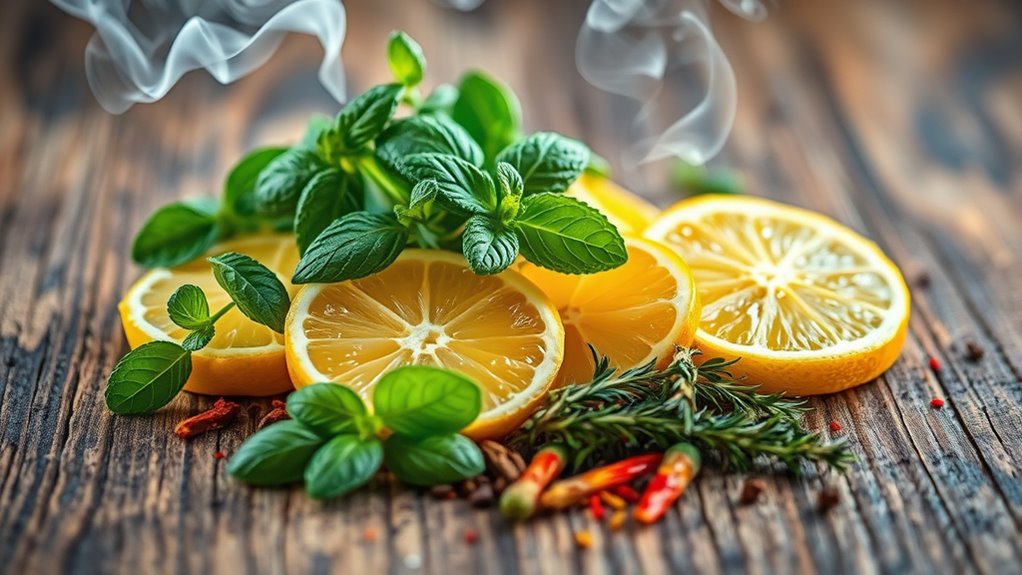
When you eat, your body processes chemical signals from both your taste buds and olfactory receptors, allowing you to experience complex flavors. These signals travel through different nerves but converge in your brain for a unified perception. The retronasal olfaction process is key: odor molecules from inside your mouth travel up to your nasal cavity, enhancing flavor. Imagine this interaction like:
| Taste Buds | Olfactory Receptors | Brain Integration |
|---|---|---|
| Detect sweet | Detect volatile odors | Merge signals in cortex |
| Detect salty | Detect aromatic compounds | Create flavor image |
| Detect bitter | Detect pungent aromas | Form full flavor perception |
This seamless collaboration makes flavors rich and multi-dimensional, with smell considerably amplifying taste experiences. The effectiveness of this process can be influenced by factors such as sensory adaptation and environmental conditions.
The Impact of Molecular Shape and Chirality on Olfactory Responses

Molecular shape and chirality play crucial roles in how olfactory receptors detect odors, shaping your perception of smell.
You see, chirality involves molecules with non-superimposable mirror images, called enantiomers, which, despite sharing physical and chemical properties, often smell different because they interact uniquely with receptors. Your olfactory receptors are proteins that usually recognize only one enantiomer, fitting molecules like a “lock and key.” Research shows that enantiomers can produce different olfactory perceptions due to their stereochemistry. For example, carvone’s enantiomers smell like spearmint or caraway seeds, depending on their handedness. Shape and flexibility also matter: rigid molecules often produce distinct odors, while flexible ones might not. Additionally, the stereochemistry of a molecule determines its specific interaction with olfactory receptors, further influencing scent detection.
In essence, the 3D structure and chirality of molecules directly influence how your nose perceives odors, making scent recognition a finely tuned biological process.
How Specific Receptor Interactions Create Distinct Smells and Tastes

Your ability to distinguish different smells and tastes depends on how specific molecules interact with unique receptors in your nose and mouth. In your olfactory system, each receptor protein is tuned to detect particular odor molecules, thanks to about 1,000 genes coding for these receptors. When an odor binds, it triggers a signaling pathway, generating action potentials that your brain interprets as a distinct smell. Similarly, in taste, tastants bind to specific receptors on taste cells, initiating a cascade that produces a taste sensation. The table below shows how receptor types correspond to different molecules:
| Receptor Type | Molecule Interaction | Perception |
|---|---|---|
| Olfactory | Odor molecules | Smell |
| Gustatory | Tastants | Taste |
| Both | Specific binding | Unique perception |
This precise interaction creates the rich array of smells and tastes you experience daily, influenced by the receptor specificity that allows for such detailed discrimination.
The Influence of Olfactory and Gustatory Signals on Food Choices
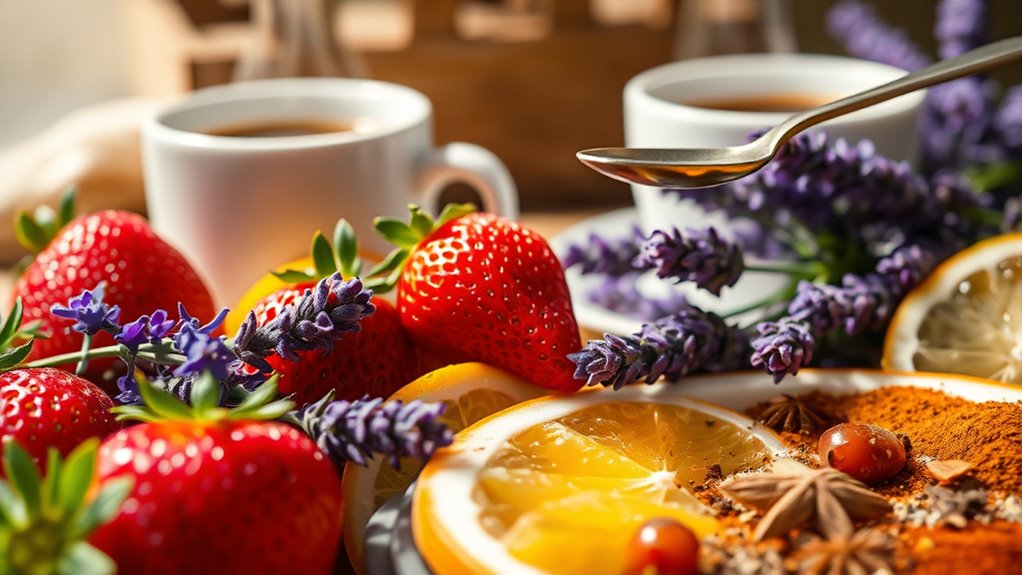
Olfactory and gustatory signals play an essential role in shaping your food choices by providing sensory information that influences your preferences and eating behaviors. Your genetic makeup affects how you perceive tastes and smells, which can alter your food preferences and consumption patterns. Utilizing vertical storage solutions can also help organize your kitchen to better support mindful eating and reduce clutter. Differences in chemosensory gene expression explain why some people are more sensitive to bitter, sweet, or savory flavors, impacting their dietary choices. These sensory experiences, combined with texture and aroma, determine how much you enjoy and accept certain foods. Your senses also help detect nutrients and toxins, guiding safe eating habits. Additionally, flavor perception, built on the integration of smell and taste, influences your cravings and overall satisfaction, ultimately shaping your long-term eating patterns.
Practical Applications: Designing Better Flavors and Fragrances
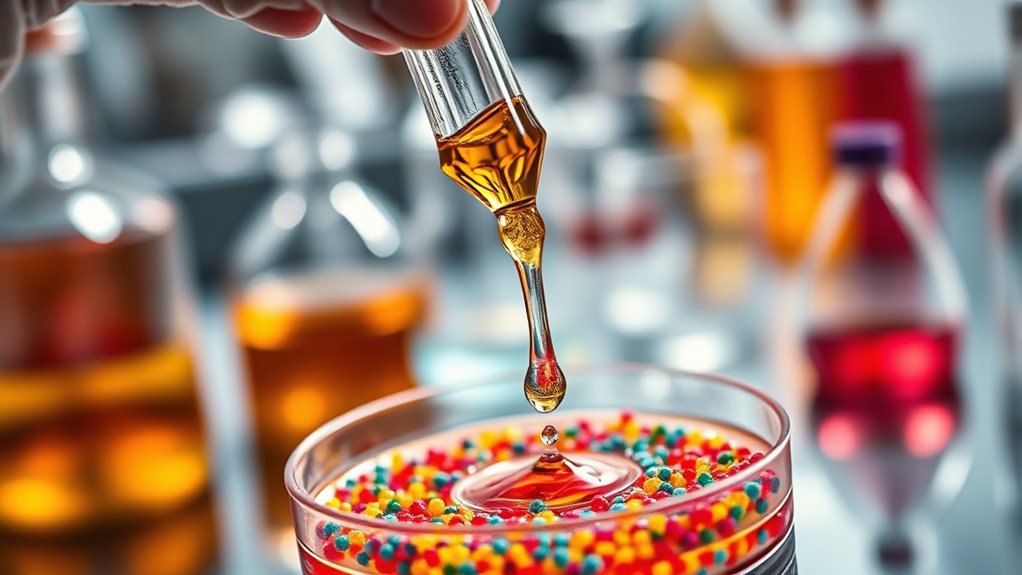
Designing better flavors and fragrances involves combining scientific insights with creative techniques to craft appealing sensory experiences. You can use natural aroma chemicals from essential oils, resins, and plant extracts like jasmine and sandalwood, extracted through methods like steam distillation or cold pressing. These compounds shape the top, middle, and base notes of perfumes, evoking emotions and memories. Blending them carefully guarantees complex, harmonious scent profiles. Synthetic chemistry also plays a role, allowing you to replicate or modify natural molecules for consistency and innovation. Additionally, deep neural networks help predict and generate scents efficiently, reducing development time. The industry’s evolving landscape emphasizes the importance of understanding Worth in creating compelling fragrances and flavors.
Insights Into Sensory Disorders and Future Directions in Chemical Senses
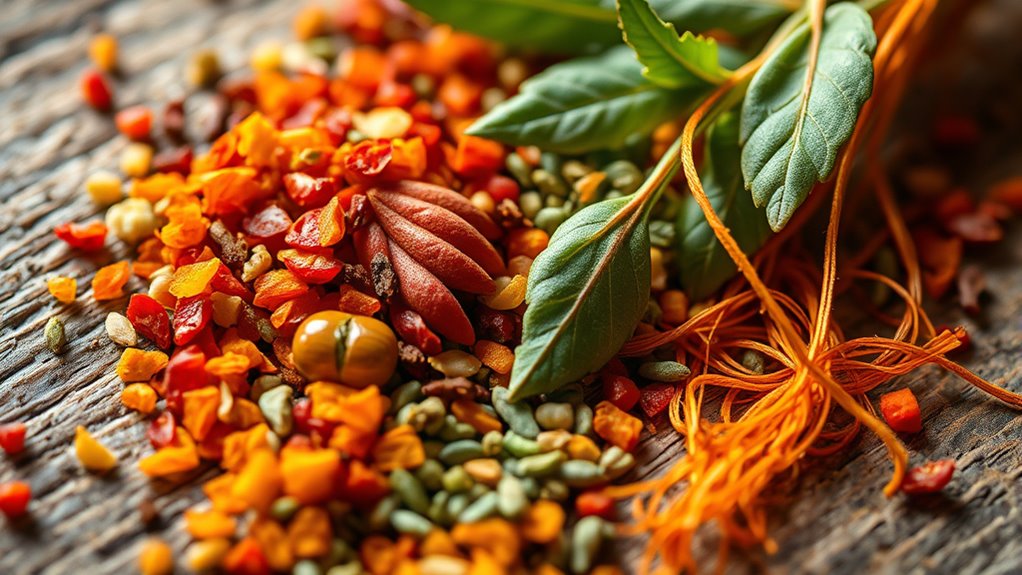
Sensory disorders affecting smell and taste are complex conditions that can considerably diminish quality of life. These issues, like anosmia, phantosmia, ageusia, and dysgeusia, often stem from nerve damage, infections, or neurological diseases. They can lead to nutritional deficiencies and emotional distress. Future research aims to promote nerve regeneration, improve early diagnosis, and understand environmental impacts. Advances include exploring molecular mechanisms and neural pathways, offering hope for better treatments. Here’s an emotional glimpse:
| Loss & Impact | Hope & Future |
|---|---|
| Complete smell loss | Regenerative therapies |
| Distorted taste | Early detection tools |
| Perception of odors | Personalized treatments |
| Increased risk | Better understanding of causes |
Furthermore, understanding the molecular mechanisms underlying these conditions may lead to targeted therapies that restore normal sensory function.
Frequently Asked Questions
How Do Our Brains Combine Smell and Taste Information?
You might wonder how your brain combines smell and taste. When you eat, signals from your taste buds go to the gustatory cortex.
Meanwhile, smell signals travel through the olfactory bulb. Your brain then merges these signals in areas like the insula and frontal lobe, creating a unified perception of flavor.
This integration enhances your food experience and helps you recognize and enjoy different tastes and aromas.
Can Smell and Taste Disorders Be Cured or Treated?
You wonder if smell and taste disorders can be cured or treated. The good news is, many conditions improve with proper treatment.
Depending on the cause, doctors might prescribe medications like steroids or antibiotics, or recommend olfactory training to stimulate nerve recovery.
Good oral hygiene and addressing structural issues also help.
However, some cases might be permanent if nerves are severely damaged.
Early diagnosis improves your chances of recovery.
Why Do Some Molecules Smell or Taste Differently Despite Similar Structures?
You might think that similar molecules would smell or taste alike, but that’s not the case—it’s like comparing apples to oranges. Chirality plays a big role here; molecules with different 3D structures interact differently with your sensory receptors.
This causes your brain to interpret them as distinct smells or tastes, even if they look alike. So, tiny differences in structure lead to big differences in perception.
How Do Artificial Flavors Mimic Natural Scent and Taste Profiles?
You might wonder how artificial flavors mimic natural scent and taste. Chemists select specific compounds, mainly esters, that replicate key aroma and flavor notes.
They mix these chemicals in precise amounts to reproduce complex flavors like orange or banana, often using just a few ingredients. This approach makes artificial flavors affordable and consistent, allowing you to enjoy familiar tastes without relying on natural sources.
What Role Does Genetics Play in Individual Sensory Perception?
Imagine your senses as a complex map, with genetic markers guiding your perception. Genetics determine how sharply you detect flavors and aromas, influencing your food preferences and responses.
Variations in genes affect your sensory organs and processing speed, creating unique taste experiences. So, your genetic makeup holds the key to why some flavors excite you while others don’t, shaping your individual sensory world in ways you might never fully realize.
Conclusion
Understanding how your smell and taste work is like revealing a secret code that turns chemicals into vivid flavors and aromas. By knowing how your receptors detect and interpret these signals, you can appreciate the intricate dance happening in your senses every time you enjoy your favorite food or scent. It’s truly a symphony where chemistry conducts the orchestra, making each bite and whiff a unique masterpiece you experience with every breath and taste.









